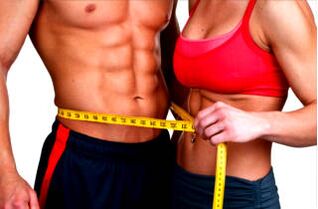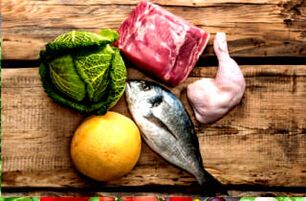The keto diet is not a popular diet. However, it is similar to many other more touted nutrition systems - Atkins, Dukan, and others. All of these diets are low in carbohydrates. They involve the almost complete rejection of carbohydrates in the daily diet. It is very effective for losing weight and burning subcutaneous fat. Those extra pounds are melting right in front of our eyes! Additionally, the keto diet is a favorite of athletes as it allows you to lose weight without sacrificing muscle mass.
The principle of the diet
Today our diet is excessively saturated with carbohydrates, especially fast ones. Sandwiches, chips, snacks, bars - these snack on the run products are the real carb time bomb. This style of nutrition provides not only overweight, but also contributes to the development of diabetes, atherosclerosis. An excess of fast carbohydrates slows down the metabolism, causes lethargy, drowsiness.
However, the useful slow carbohydrates contained in cereals contribute to weight gain. The fact is that all carbohydrates, once ingested, are converted into glucose, which is needed for energy.
How does the keto diet work? With a significant limitation of carbohydrate intake, the way the body works is rebuilt. Nature has devised reserve mechanisms to obtain energy for life processes. If the amount of glucose obtained from carbohydrates in the diet approaches zero, the body begins to produce it, breaking down fat stores. This process is called ketosis, hence the name of the diet: ketone or ketogenic.
Instructions for the correct preparation of the menu
To properly compose a menu for a ketone diet, you will have to work a little. First of all, you need to calculate your daily calorie intake. This can be done online with the help of special programs.

Once you've determined your daily calorie intake, it's important to choose a keto diet goal. To lose weight, you need to subtract 500 kcal from the resulting figure, to gain muscle mass, add 500 kcal.
Then we calculate the required daily amount of proteins, fats and carbohydrates. Carbohydrates should not be more than 10%, you should try to get the missing calories not at the expense of fat, but at the expense of protein. It sounds complicated enough, but again, with the help of an online food diary, anyone can check the ratio of KBJU in the diet.
Let's take a calculation example. A woman weighing 60 kg, the percentage of fat is 20 (you can determine the percentage of fat visually or using a special analyzer). The daily calorie intake was 2000. To lose weight, subtract 500, we get 1500 kcal per day. Let's calculate BJU. For 1 kg of muscle mass, 2, 2 g of protein (4 kcal), 0, 4 g of carbohydrates (4 kcal) are needed, the remaining kilocalories are left for fat at the rate of 9 kcal per 1 g of fat. So, 60kg - 20% = 48kg of muscle mass.
Protein 2, 2 * 48 \ u003d 106 g (424 Kcal)
Carbohydrates 0. 3 * 48 \ u003d 19 g (76 Kcal)
1500-424-76 \ u003d 1000 kcal, which is about 110 g of fat per day.
Simplified instructions
Adherence to the formulas for calculating the menu is necessary for people whose lives are related to training. For people who are far from sports, there is an easier option to determine the diet with a ketogenic diet. There are two lists: these are recommended and prohibited products.

Recommended products:
- Meat
- Bird
- Fish
- Dairy products
- peanuts
- Cheese
- Vegetables (except potatoes, beets and legumes)
Prohibited:
- Any sweets, incl. sugar
- Bakery products
- Pasta
- Fruit, incl. dried fruit
- cereals
With a keto diet, you need to monitor the amount of carbohydrates in your food. This information can be obtained from the product packaging (if it is a finished food product) or by looking at the nutrition tables. In general, you should give preference to products that contain no more than 10 g of carbohydrates per 100 g. Following this rule, it is quite easy to make a list of products to buy and develop a menu for a week.
Example of a keto diet menu

Option 1:
- Breakfast: omelette with cheese.
- Lunch: vegetable soup with chicken broth, a piece of rye bread.
- Afternoon snack: yogurt.
- Dinner: stewed beef, fresh vegetable salad.
Option 2:
- Breakfast: cottage cheese with sour cream.
- Lunch: boiled chicken breasts with buckwheat.
- Afternoon snack: nuts.
- Dinner: salmon with vegetables, baked in foil.
During the day, it is necessary to drink enough water (about 2 liters per day). Unsweetened tea and coffee are allowed. In addition, it is recommended to eat fiber to normalize digestion processes.
Contraindications
Low-carbohydrate diets are dangerous due to their load on the liver, kidneys and cardiovascular system. So, for people who have problems with these organs, the keto diet is contraindicated. Also, people suffering from constipation and other digestive problems shouldn't follow the ketogenic diet. Healthy people need to consume additional vitamin and mineral complexes while on the keto diet.
The effect of the ketone diet
Reviews and results suggest that only the first 3-4 days are difficult on a keto diet. At this time, the body is restructuring itself into a ketogenic regime, so you can experience a feeling of weakness, dizziness. In the future, these negative effects disappear and the fat burning process begins. To get a good result, the diet must be followed for at least 3 weeks.
Those who have already followed a ketogenic diet notice that there is no feeling of hunger. Also, at the end of the diet, sugar cravings decrease. The body gets used to being sugar-free during the diet, which helps develop healthy eating habits. If you look at photos of people before and after a diet, you can notice the appearance of relief in the body. This is especially evident in those who do not forget physical exercises. The ketone diet is perfect for athletes, as well as anyone who wants to have a slim body!































